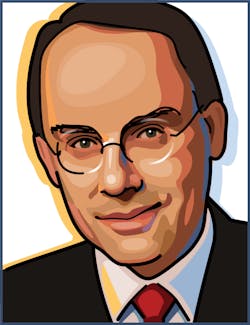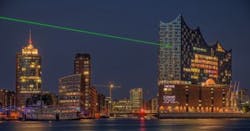The European XFEL, the largest and most powerful x-ray laser in the world, was officially inaugurated on September 1, 2017. With a budget of $1.4 billion (€1.2 billion), it is Germany's most expensive research device. Equipped with superconducting accelerator coils, it will generate 27,000 x-ray flashes per second to capture images of individual atoms with less than 100 fs time resolution.
Last week, the people in Hamburg (Germany) were excited by a very unusual nightly spectacle: Several green laser beams were shining on famous buildings in the city at a height of 50 m. They learned from local media that this installation welcomes a new scientific tool for the research on the structure of matter.
The device itself is barely visible: The European XFEL is located mainly in underground tunnels that can be accessed on three different sites. The 3.4-km-long facility will run from the DESY campus in Hamburg to the town of Schenefeld in the adjacent federal state of Schleswig-Holstein.
At present, 11 countries are participating in the project: Denmark, France, Germany, Hungary, Italy, Poland, Russia, Slovakia, Spain, Sweden, and Switzerland. The United Kingdom is in the process of joining. The construction costs of the facility amount to €1.22 billion (price levels of 2005). Germany covers 58%, Russia bears 27%, and the other international partners between 1% and 3%.
After eight years of construction the facility was officially inaugurated last Friday. Eight hundred guests, including Ministers for Science from Germany and France as well as high-ranking politicians from Russia, joined for this event. Prof. Dr. Helmut Dosch, chairman of the DESY Board of Directors, said: "What started as a vision and was set in motion at DESY more than 20 years ago has now become a reality: the world's most powerful laser for x-ray light. Now, scientists from around the world will conduct research at this most advanced high-speed camera for the nanocosmos in the world, and I wish them many exciting results—both fundamental and revolutionary."
How it works
Precise electron bunches are generated by knocking the particles out of a piece of metal using a conventional laser. Those electrons are then injected to a 1.7-km-long linear accelerator that brings them to high energies at nearly the speed of light.
The accelerated electrons then race through long undulators, periodic arrangements of magnets that force the electrons onto a tight slalom course. There, electrons emit x-ray radiation that amplifies more and more.
Because the radiation is faster than the electrons speeding, the radiation overtakes the electrons flying ahead and interacts with them along the way, accelerating some of them and slowing others down. The electrons gradually organize themselves into a multitude of thin disks. The key property of this process is the fact that all of the electrons in a given disk emit their light "in sync." This produces extremely short and intense x-ray flashes with the properties of laser light.
In its initial configuration, the European XFEL will provide three undulators with six experiment stations. Eventually, this will be expanded to five undulators with 10 instruments, and perhaps even more.
Compared to other FEL projects (see table), the European XFEL offers the best parameters for a number of fundamental and applied research projects ranging from medicine and pharmacology to chemistry, physics, and materials.




